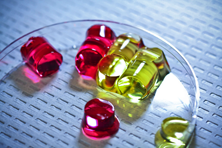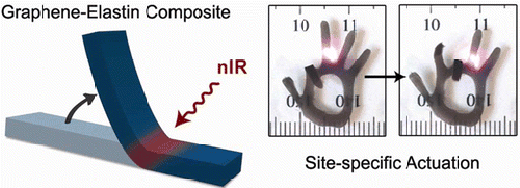Shapeshifting Phototrophic Hydrogels and More…

Bioengineers at University of California, Berkeley have developed a phototrophic hydrogel that can be manipulated using near infrared light. The phototropic hydrogels opens new avenues for research in the field of soft robotics, drug delivery systems and tissue engineering.
This phototrophic hydrogel mimics the way plant cells respond to light and is made of a combination of synthetic elastin like proteins and graphene sheets of one carbon atom thickness. When exposed to near infrared light, the graphene sheet heats up and affect the synthetic proteins. The protein layer releases water when it gets hot and absorbs when cooled.
One side of the hydrogel is more porous than the other to allow faster absorption and release of water than the other side to offer precise control over the contraction and expansion of the material in response to light. The shape shifting characteristics of this nanocomposite biopolymer makes it ideal for drug delivery and tissue engineering applications, the following video shows how the material can be manipulated using light.
Different hydrogels respond to different kinds of stimuli. Earlier this year IBM Research in collaboration with Institute of Bioengineering and Nanotechnology, Singapore has developed a new hydrogel with antimicrobial applications. This antimicrobial hydrogel is composed of more than 90 percent water, biodegradable, biocompatible, non-toxic and is positively charged. It self assembles when warmed to body temperature to form a thick gel.
This hydrogel is easily miscible with water and it can be applied on surfaces contaminated with bacteria or injected to site of an abscess for disinfection. Due to its water like property, it can easily penetrate microbial biofilms to attach itself to negatively charged bacterial cell walls and rip it apart as it self-assembles into a think gel. It uses physical methods of disinfection, making it effective against antibiotic resistant strains of bacteria as well. It can be used against a wide range of bacteria and will be instrumental in combating serious health hazards faced by hospital workers, patients and visitors.
Source: UC Berkeley / IBM Research

